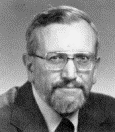Department of Physics and Astronomy: Publications and Other Research
Date of this Version
7-15-1975
Abstract
A deformation-dipole model with first- and second-neighbor central short-range forces is used as a basis for calculating all symmetry-adapted combinations of eigenvectors (SACEV) necessary for the study of defect vibrations in alkali-halide crystals. As an example of the full set of spectral weight functions, which are tabulated separately, sample results are given for the predicted defect-activated E, Raman spectra for KCl, KI, RbCl, and KBr, assuming no force-constant changes and that the defect is located at a positive-ion site. The results show qualitative agreement with the earlier findings of Harley, Page, and Walker, even though the deformation-dipole model is not adjusted to fit measured dispersion curves. The SACEV compilations, therefore, should be helpful to other researchers initiating defect studies and needing first-trial solutions to use as a basis for subsequent, more refined theoretical investigations.


Comments
Published in Physical Review Volume 12, Number 2, 15 July 1975. Copyright 1975. Used by permission.